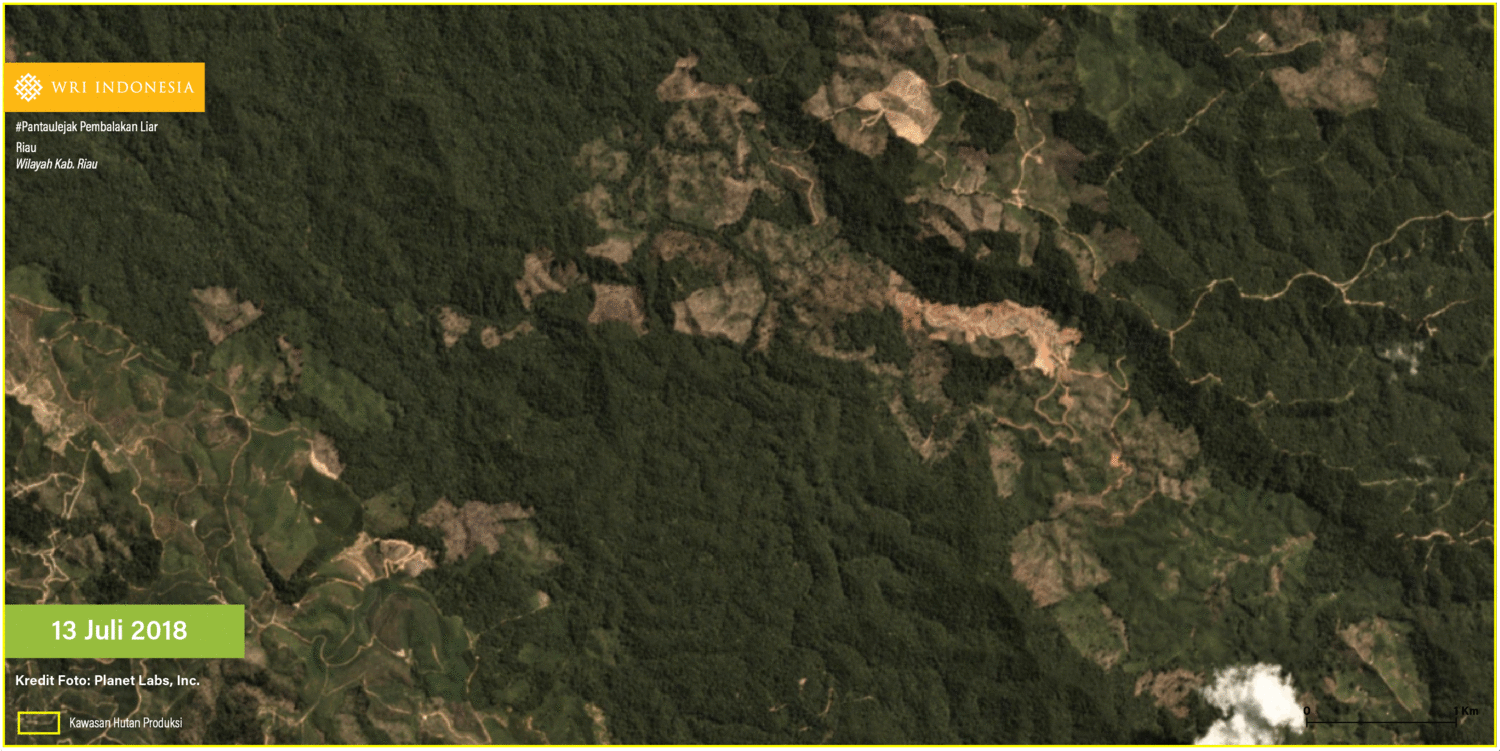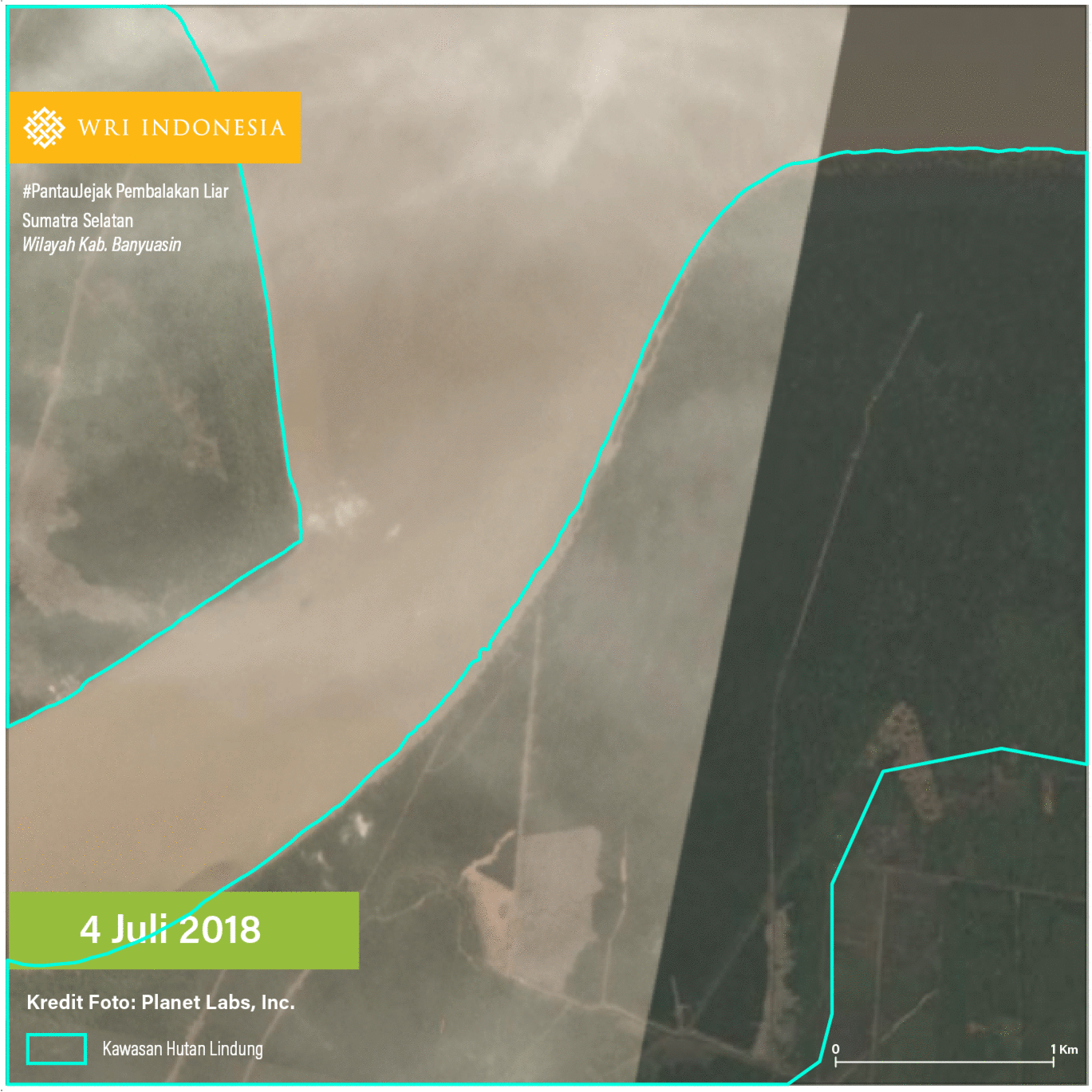Places to Watch Third Edition: Five Indicated Illegal Logging Area in Indonesia
This third part features the top 5 Places to Watch for indications of illegal logging between 01 July to 30 September 2018
1 Indications of Illegal Logging in a 389-hectare Area to Clear Land for a Plantation using Slash-and-Burn Techniques within a Convertible Production Forest at Berau Regency, East Kalimantan.

Illegal logging has been indicated to occur in a 389-Ha area at the Derawan Island Sub-district. This area is the expansion of Indicated Area #3 for illegal logging from the second part of Places to Watch – in this edition the Indicated Area has even grown from 208 Ha to 389 Ha with an increase in logging rates from about 69 Ha/month to about 130 Ha/month.
Such deforestation has been indicated to be a part of land clearing activities for the extension of plantation areas in the eastern part of the First Indicated Area (#1). The expansion is done by cutting trees and burning down the land. Similar to what was identified in the second part of Places to Watch, blackish brown burn scars were seen in the cleared areas, indicating the remaining burnt biomass. The burnt area indicated by satellite imagery acquired on 30 September did not show any standing trees, indicating that the burning was carried out following a slash-and-burn.
Throughout September, there were 11 incidents of intentional land and forest fires in the Berau Regency. The fact that these actions were intentional was confirmed through findings by the Berau Regional Disaster Management Agency in a number of spots where land and forest fires occur, including in Derawan Island Sub-district, where a number of trees were cut down first and allowed to dry, followed by burning.
2 Indications of Illegal Logging in a 348-Ha Convertible Production Forest area at Kampar Regency, Riau Province

The second Indicated Area (#2) is located in the XIII Koto Kampar and Kampar Kiri Sub-districts, Kampar Regency. The loss of forest cover within the production forest areas is scattered and irregular. Satellite imagery observation shows patterns of logging activities but no visible signs of planting following land clearing.
There is plenty of media coverage regarding illegal logging activities in the Kampar Regency. The latest news item states that logs were found on the Subayang River, which is a part of the administrative area of the Kampar Regency. The Kampar Departmental Police (Polres) and Natural Resources Conservation Center (BKSDA) of Riau have put special attention on the handling of this case.
#3 Indications of Illegal Logging in a 118-Ha Convertible Production Forest Area for Agricultural Land Clearing Using Slash-and-Burn Techniques in Tanjung Jabung Barat Regency, Jambi Province

The third Indicated Area (#3) is located in the Sungai Beremas Sub-district, Pasaman Barat Regency. There are two different land clearing patterns observed in this area. In the eastern part, illegal logging has been indicated to occur in production forest areas with sporadic land clearing patterns, evidencing land conversion for agricultural activities by smallholders. Meanwhile in the northwestern part, indications of land clearing were observed within a production forest area adjacent to an area of other use (APL). Loss of forest cover in this area was more massive, indicating an expansion of land clearing within the APL, but it is yet to be seen what business activities encouraged such land clearing.
Based on documents from the Regional Development Planning Agency of the Pasaman Barat Regency, land use in Pasaman Barat is dominated by non-rice agricultural fields. Furthermore, the Sumatra Ecoregion Management Center of the Ministry of Environment and Forestry stated that the Pasaman Barat Regency is one of the regions in Sumatra with a large amount of critical lands due to the rapid conversion of land/forest and development of its plantation sector.
#4 Indications of Illegal Logging in a 118-Ha Convertible Production Forest Area for Land Clearing using Slash-and-Burn Techniques in the Tanjung Jabung Barat Regency, Jambi Province

The fourth Indicated Area (#4) is located in the Batang Asam Sub-district, Tanjung Jabung Barat Regency. Analysis of high-resolution satellite imagery shows a sporadic pattern of land clearing, indicating agricultural activities of independent smallholders. Another indicator is a blackish hue or burn scars in an area that was cleared at the end of the observation period (28 September 2018). No leftover tree trunks are found in the burnt area, indicating that the land was cleared by burning the area after the trees were cut down.
This Indicated Area is adjacent to Indicated Area #4 on the second part of Places to Watch with indications of logging found in a more extensive area. Analysis of high-resolution satellite imagery indicates that the cause of land cover loss is similar, which is land clearing for new agricultural activities.
#5 Indications of Illegal Logging in an 86-Ha Forest Area for Palm Oil Plantation Expansion in the Banyuasin Regency, South Sumatra Province

The Indicated Area is a mangrove forest located in Makarti Jaya and Air Salek Sub-districts, Banyuasin Regency. High-resolution satellite imagery shows a pattern of massive land clearing in even blocks. Interpretation of the latest satellite imagery during this observation period (15 September 2018) has not shown any planting activities after land clearing. However, the Indicated Area is very near (approximately 800 meters) to a palm oil plantation and there is road access connecting the two. As such, this case of land clearing is suspected to be an expansion of the existing palm oil plantation in the southern part of the area.
According to the Long-Term Forest Management Plan of the Protected Forest Management Unit (KPHL) 1 Banyuasin for the 2015-2024 period, the strategic issue in forest management for KPHL 1 Banyuasin (including at Indicated Area #5) is the number of permanent plantations within the KPHL 1 Banyuasin Area and the great land needs for non-forestry activities. The location of this area is also adjacent to Indicated Area #2 for illegal logging in the previous part of Places to Watch, which was indicated as being used for aquaculture.
The Next Step
While these Places to Watch are determined based on indications only, they can be used in determining priority areas for monitoring. To that end, the following steps need to be taken immediately.
1. Field Verification and Action to Prevent Expansion of Illegal Logging in the Five Indicated Areas
All five Indicated Areas are not the first in their respective regions to suffer from illegal logging. Rather, these are extensions/expansions from ongoing activities. These Indicated Areas are at risk of continued logging expansion into the surrounding forests. As such, authorities in charge of forest protection at the Indicated Areas must immediately conduct field verification and take action to prevent further illegal logging and illegal forest utilization. Community participation in providing information from the field may help in the verification process. As the forest area that has been cleared and utilized for non-forestry activities grows larger, its management and restoration will become more challenging.
The Indicated Areas, especially Indicated Area #1 – Berau Regency, #4 - Tanjung Jabung Barat Regency, and #5 – Banyuasin Regency, must be prioritzed since these locations are close to several other Indicated Areas presented in the second part of Places to Watch. This finding indicates continuity and the potential for expansion of activities indicated to be illegal logging.
2. Upon Verification, the Handling Process Must Take into Account the Socio-economic Background of Local Communities
Illegal logging across the five areas is closely associated with small-scale economic activities. As such, upon verification, the handling process must take into account the socio-economic background of the local communities. The handling mechanism may include logical and fair conflict resolution, social forestry and law enforcement schemes. In addition, it is also necessary to trace the perpetrators back to the masterminds (intellectual players) who are reaping the ultimate benefits of illegal logging.